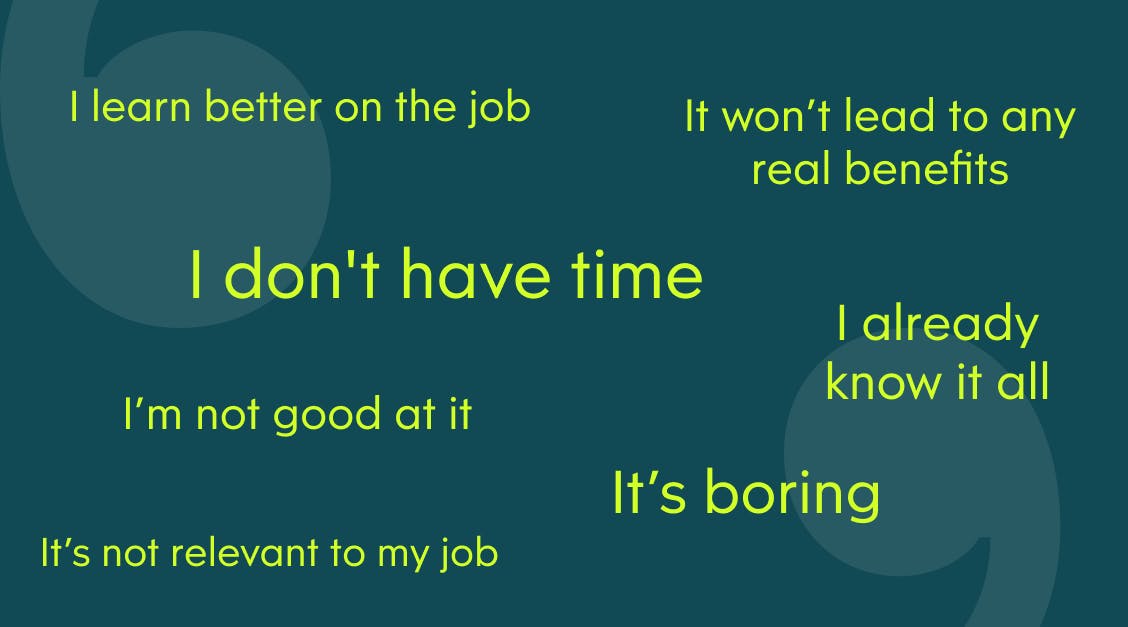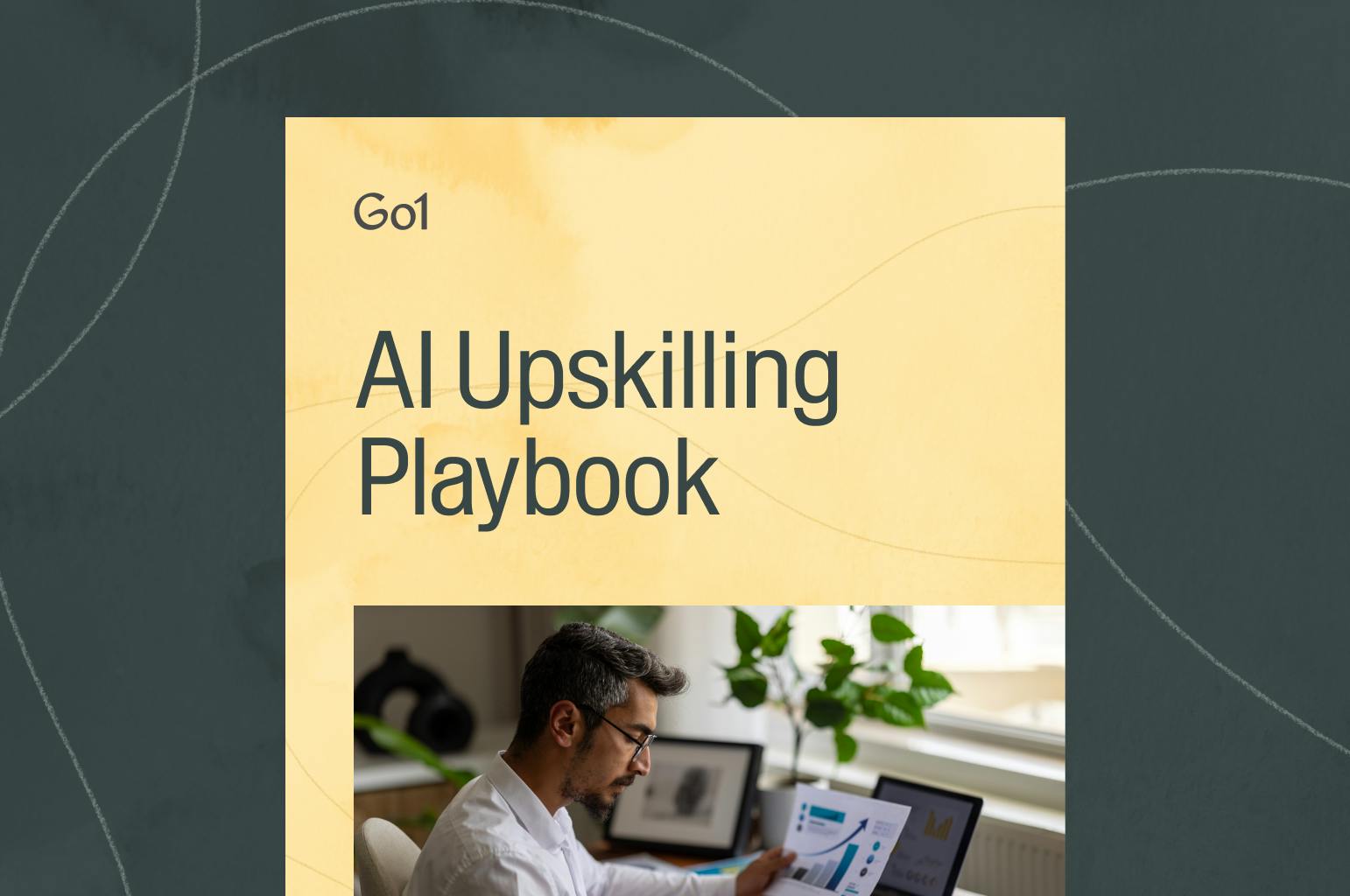Eight common objections to workplace learning

While it’s true that workplace learning leads to greater employee productivity — and is even one of the top factors that job seekers look for in companies — not everyone is interested in learning and developing new skills.
When employees are resistant to learning, it not only hurts their chances of personal and professional progression, but it can also hurt an organization’s ability to retain talent. So, how do you engage and motivate employees to learn when they’re disinterested, burnt out, or generally unmotivated?
In this article, we’ll tackle some of the most common objections to workplace learning and how organizations can navigate them.

The eight most common objections to workplace learning
1. "I don't have time"
Burnout is real. Employees everywhere have a lot of work on their plates, in addition to personal responsibilities, and are often overwhelmed by the prospect of taking something else on, even if that additional task is beneficial to them in the long run.
That’s why, when encouraging employee learning, try to integrate training into daily work routines (i.e. learning in the flow of work) rather than treating it as a separate activity. Self-directed learning, mobile-friendly programs, or platforms that offer microlearning tools — like Blinkist, which is available through Go1 Premium Pro — can allow employees to learn on the go, and in short bursts that could take just 1-5 minutes at a time.
2. "It's not relevant to my job."
Unfortunately, many learning programs are one-size-fits-all, giving all employees — regardless of their roles — the same learning materials and objectives. When that happens, employees can become disengaged.
To overcome this, use an LMS that offers curated, personalized training paths that are tailor-made to specific employees in different functions don’t have to experience the same courses. The content should involve real-world examples and case studies relevant to specific jobs, so employees can see exactly how learning materials can be applied to their everyday roles.
Pro tip: When creating these personalized learning paths, be intentional about listening to your employees. Asking for their input on their learning objectives, skill gaps, and their preferred ways to learn will encourage them to engage and make them feel like they were a part of the process.
3. "I'm too old to learn new things."
There's a growing gap in how different generations take an interest in learning. They also have very different preferences in learning formats.
To address these disparities, deploy several learning strategies for your multi-generational workforce:
- Baby Boomers: To support Baby Boomers in their learning journey, use structured, well-organized training programs led by a real person. This might include in-person workshops, webinars led by employees from your organization, or expert guest speakers from outside your business.
- Gen X: A learning program that works for Gen X will include mentorship and feedback, hands-on learning, and flexible, self-directed courses. Be sure to recognize milestones and track progress, too.
- Millennials: A somewhat digital-native generation, Millennials were born during a period of high technological change (VCRs, smartphones, etc.). To engage them, be sure to offer self-directed video courses and microlearning options that align with their comfort with technology.
- Gen-Z: To engage a true digital native generation, use a training program that offers both bite-sized learning content and opportunities to learn in groups. This might include mentor training and peer-learning cohorts.
4. "I already know everything I need to know."
Lots of experienced employees become comfortable in their roles and often don’t recognize the rapidly changing nature of their industries or the need for continuous upskilling.
To navigate this resistance, be sure to:
- Partner with the right providers: Use software that offers automatically updated content. Employees will quickly see how much new information is coming in and how important it is to learn and understand.
- Create opportunities for leadership: For very knowledgeable employees, you might invite them to share their knowledge through a course to help their peers learn and grow.
5. "The training is boring or ineffective."
When training isn’t engaging, it’s boring. Employees aren’t going to be excited about learning when the material and format are dull and uncreative.
To address this, be sure to invest in high-quality, interactive training materials, utilize diverse learning methods (e.g., gamification, simulations, peer learning), and regularly gather and act on feedback. You might also consider bringing in respected industry professionals or internal experts to add credibility and real-world insights to the training, too.
6. "I learn better on the job."
Many employees who are accustomed to lecturing as a method for learning and development often think hands-on learning is superior. But, the truth is, both are important.
To overcome this objection, use a blended learning approach that combines formal training with practical application. You might even implement mentoring or shadowing programs where employees can learn skills in real time on the job.
7. "It won't lead to any real benefits."
Employees may resist learning if they don't see a clear connection to career advancement, increased compensation, or other concrete benefits.
To address this, clearly communicate how learning ties into career progression using training engagement — or even how soft skill development can lead to long-standing employability.
Pro tip: Try linking the completion of learning programs to performance reviews or promotion criteria to motivate employees even further.
8. "I'm not good at learning."
Sometimes, employees have had past negative experiences with education or training. So, becoming interested in new training and development programs can feel challenging from the outset.
However, organizations can overcome this by providing multiple learning formats, like microlearning, interactive courses, podcasts, practice labs, and more on subjects like emotional intelligence and communication. With Go1, employees can engage with the topics, languages, and formats that help them learn best.
Building workforce engagement with Go1
Not everyone is going to be excited to learn. But with the right strategies, you can convince any employee to take their professional growth seriously.
With tools like Go1, which offers a variety of upskilling and compliance courses, personalized learning paths, and learning formats, employees can get engaged and excited about upskilling.
Ready to see Go1 in action? Book a personalized demo to discover how our platform can transform your L&D strategy.
Related Articles

Application Guide: How to use the Go1 AI for L&D Maturity Assessment to assess our workforce AI capability

AI upskilling made clear: A practical guide to building an AI-ready workforce

Go1 welcomes PepTalk

5 Data-Backed Insights Shaping the Future of AI in Workplace Learning

Train smarter, spend less
Train smarter,spend less
Connect with a Go1 expert to explore the best training options for your organization—no pressure, just solutions that work.